Comments / Questions (4)
![]() Gabriela wrote:
Gabriela wrote:
Buenas noches una consulta tenemos las 2 partes del circulo, trabajamos 1 ovoide y tomamos 1 punto de cada lado del otro ovoide que esta en 3 agujas aux cuando tenemos 86 puntos de un ovoide, dejamos los puntos restantes del otro ovoide en espera para el escote. Gracias de antemano
03.04.2023 - 05:43DROPS Design answered:
Hola Gabriela, sí, es correcto.
10.04.2023 - 17:29
![]() Kathy wrote:
Kathy wrote:
Hallo! Ich habe eine Frage zur Größe XXL: im Abschnitt ...in dieser Weise (in Glattstr.) stricken: *3M stricken danach diese M auf 1 Hilfsfaden legen (Faden-2), die restlichen M auf der Ndl stricken, die Arbeit wenden, 3M stricken..... Wenn man das noch 5x wiederholt ergibt das 36 M. Danach soll man noch jeweils 4 M (also insges. 8M) auf Faden 2 und Faden 3 legen. Das wären dann 44 M. Ich verstehe daher nicht wie man auf 26 M kommen soll.
26.06.2018 - 17:12DROPS Design answered:
Liebe Kathy, zuerst werden insgesamt 6 Mal 3 Maschen auf beiden Seiten auf 1 Hilfsnadel gelegt (= 6 x 3 M = 18 M auf beiden Seiten), dann stricken Sie noch 4 Reihe aber jetzt legen Sie 4 M auf beiden Seiten = es werden 2 x 4 M auf beiden Seiten gelegt: 18+8= 26 M sind jetzt auf jedem Hilfsnadel. Viel Spaß beim stricken!
27.06.2018 - 08:17
![]() Mona wrote:
Mona wrote:
Drops 82-8
31.03.2014 - 14:34Johane wrote:
Bonjour. j'apprecie beaucoup votre site. j'ai decele 2 erreurs jusqu'a present durant mon tricot. dans vos explications du cercle. taille XL devrait se lire: arreter ici, sauter les rangs 21 a 22. Plus loin on lit: Tricoter ensuite 4 rangs de plus de la même façon, mais mettre cette fois 4 m de chaque côté en attente sur les arrêts de mailles 2 et 4. on devrait lire: les arrets de mailles 2 et 3.
23.12.2012 - 04:36DROPS Design answered:
Bonjour Johane et merci, ces 2 erreurs ont été corrigées. Bon tricot !
24.12.2012 - 16:06
Starburst |
|
 |
 |
DROPS Top in Paris.
DROPS 82-7 |
|
|
Gauge: 17 sts x 22 rows in stockinette st = 10 x 10 cm Knitting tip: To «knit in» the st from the st holder every other row, just put the st onto the needle and knit as the first st of the next row. Front: Start at the center of the circle and knit out. Circle: Cast on 5 sts and divide them onto 4 double-pointed needles; join and place a marker at the join. Row 1 (and all odd-numbered rows): knit. Row 2: * K 1, yo *, repeat * - * = 10 sts. Row 4: * K 1, yo *, repeat * - * = 20 sts. Row 6: * K 2, yo *, repeat * - * = 30 sts. Row 8: * K 3, yo *, repeat * - * = 40 sts. Row 10: * K 4, yo *, repeat * - * = 50 sts. Row 12: * K 5, yo *, repeat * - * = 60 sts. Row 14: * K 6, yo *, repeat * - * = 70 sts. Size S ends here. Skip rows 15-22. Row 16: * K 7, yo *, repeat * - * = 80 sts. Size M ends here. Skip rows 17-22. Row 18: * K 8, yo *, repeat * - * = 90 sts. Size L ends here. Skip rows 19-22. Row 20: * K 9, yo *, repeat * - * = 100 sts. Size XL ends here. Skip rows 21-22. Row 22: * K 10, yo *, repeat * - * = 110 sts. Size XXL ends here. All sizes: Knit 1 row. Put 1 marker at the beginning of the row and 1 marker after 35-40-45-50-55 sts. The circle measures approx. 13-15-16-18-20 cm in diameter. Now continue over only the sts along one half of the circle so that it will appear to be an oval, the other half (= 35-40-45-50-55 sts) put on a st holder (= st holder-1). Knit as follows (in stockinette st): * knit 3 sts, put them then on a st holder (= st holder-2), knit the remaining sts, turn the work, knit 3 sts and put them on a st holder (= st holder-3), knit across row, turn the work *, repeat from * - * 1-2-3-4-5 times more. Then knit 4 rows more in the same manner, but now put 4 sts at each side on st holder-2 and st holder-3. After this is complete there are 14-17-20-23-26 sts on st holder-2 and st holder-3, knit 1 row over the remaining 7-6-5-4-3 sts and put them on one of the st holders. Put the sts from st holder-1 back on needles and knit in the same manner as the other side of the circle. Put all sts back on a short circular needle and knit 1 row, at the same time picking up 1 st between each place where the sts divide the circle in two – pull up a loop between sts and twist and knit the st = 86-100-114-128-142 sts. The oval measures approx. 22-26-29-33-36 cm wide. Put the last 6-6-7-7-8 + the first 6-6-7-7-8 sts on needles on a st holder for neckband (start row at center of one long side of oval). Divide the remaining sts in three parts and put on st holders as follows: 16-19-22-25-28 sts = st holder-1, 42-50-56-64-70 sts = st holder-2, 16-19-22-25-28 sts = st holder-3. Now knit one side of bodice at a time and then the lower part of front. Right side of bodice (as when you are looking at the piece): Cast on 13-13-13-14-14 sts and knit stockinette st (measure the piece from cast-on edge) – at the same time add in sts from st holder-3 (start at right side of st holder) every other row – see Knitting tip: 1 st 2 times, 2 sts 2-2-3-3-3 times, 3 sts 2-3-3-4-5 times and then the remaining 4-4-5-5-5 sts. At the same time when the piece measures 3.5-4.5-5-6-7 cm bind off at side for armhole every other row: 4 sts 1-1-1-2-2 times, 2 sts 1-2-3-3-4 times and 1 st 4-4-5-4-5 times. After all armhole shaping and all sts from st holder-3 are added, there are 19-20-20-21-21 sts on the needles. Now bind off for the neck every other row: 2 sts 2 times and 1 st 6 times = 9-10-10-11-11 sts remain on shoulder. When the piece measures 21-23-24-26-28 cm (from cast-on edge) bind off all sts. Left bodice: Knit the same as the right side but knit in sts from st holder-1, and start at left side of st holder. Lower part of front: Pick up 1 st in each of the 13-13-13-14-14 sts at on one side of the circle. Knit stockinette st and at the same time knit in sts from st holder-2 as follows – see Knitting tip: 1 st 2-1-1-1-1 time, 2 sts 3-4-5-5-5 times, 3 sts 1-2-2-3-4 times and 4 sts 1 time = 28-32-34-38-41 sts. Put sts on a st holder. Repeat on the other side of circle. Then put all sts from lower edge on the same needle as follows: 28-32-34-38-41 sts from one side, the remaining 12-12-14-16-16 sts from st holder-2 and 28-32-34-38-41 sts from the other side = 68-76-82-92-98 sts. Measure the work from here. Place a marker 16-17-18-19-20 sts in from each side. Knit stockinette st. When the piece measures 5 cm knit the next row as follows: * knit to the first marker, yo, slip 1 as if to knit, K 2 tog, psso, knit to 3 sts before the next marker, K 3 tog, yo, knit to end of row *. Repeat from * - * every 6 rows 3 times more so that there will be 4 holes = 60-68-74-84-90 sts. Continue in stockinette st until the piece measures 47-49-51-53-55 cm. Then knit 4 rows garter st and bind off all sts. Back: Cast on 60-68-74-84-90 sts. Knit 4 rows garter st, then knit stockinette st to finished measurements. When the piece measures 10 cm inc 1 st at each side every 4.5 cm 5-4-5-4-5 times = 70-76-84-92-100 sts. When the piece measures 31-32-33-34-35 cm bind off for armhole at each side every other row: 4 sts 1-1-1-2-2 times, 2 sts 1-2-3-3-4 times and 1 st 4-4-5-4-5 times = 50-52-54-56-58 sts. When the piece measures 46-48-50-52-54 cm bind off the center 28-28-30-30-32 sts for the neck. Then bind off 2 sts at each neck edge on the next row = 9-10-10-11-11 sts remain on each shoulder. Bind off when the piece measures 48-50-52-54-56 cm. Assembly: Sew shoulder seams. Sew side seams inside of 1 edge sts. Armhole edge: Pick up approx. 65-85 sts around armhole on short circular needle. Join and knit 4 rows stockinette st, bind off. Fold edge to wrong side and sew in place to picked up sts. Repeat around the other armhole. Neckband: Pick up approx. 90-105 sts around the neck (incl. sts on st holder) on short circular needle. Join and knit 4 rows garter st, bind off. |
|
 |
|
Have you finished this pattern?Tag your pictures with #dropspattern or submit them to the #dropsfan gallery. Do you need help with this pattern?You'll find 18 tutorial videos, a Comments/Questions area and more by visiting the pattern on garnstudio.com. © 1982-2026 DROPS Design A/S. We reserve all rights. This document, including all its sub-sections, has copyrights. Read more about what you can do with our patterns at the bottom of each pattern on our site. |
|







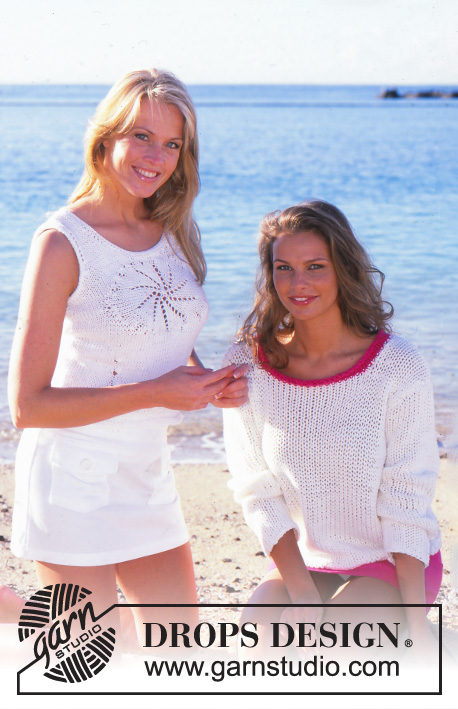

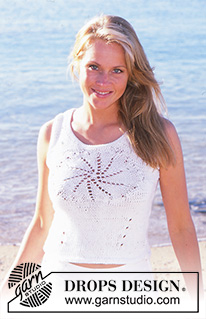
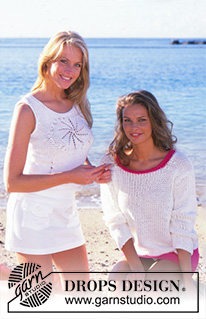






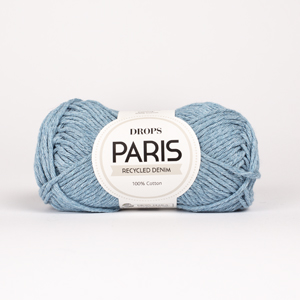
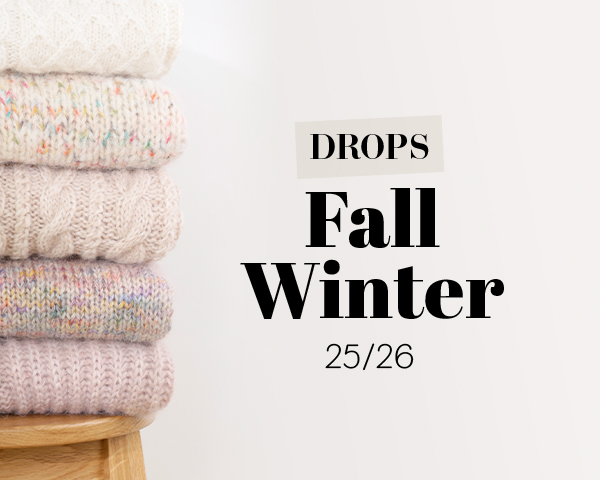

































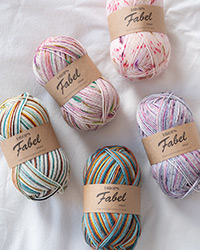
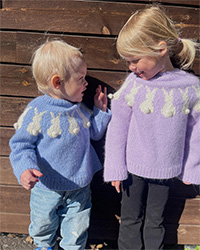
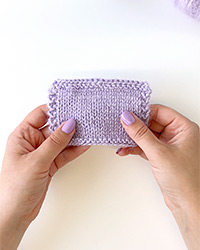
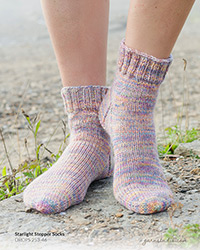
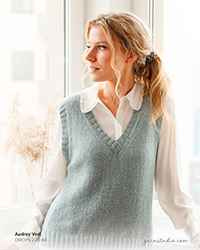

Post a comment to pattern DROPS 82-7
We would love to hear what you have to say about this pattern!
If you want to leave a question, please make sure you select the correct category in the form below, to speed up the answering process. Required fields are marked *.